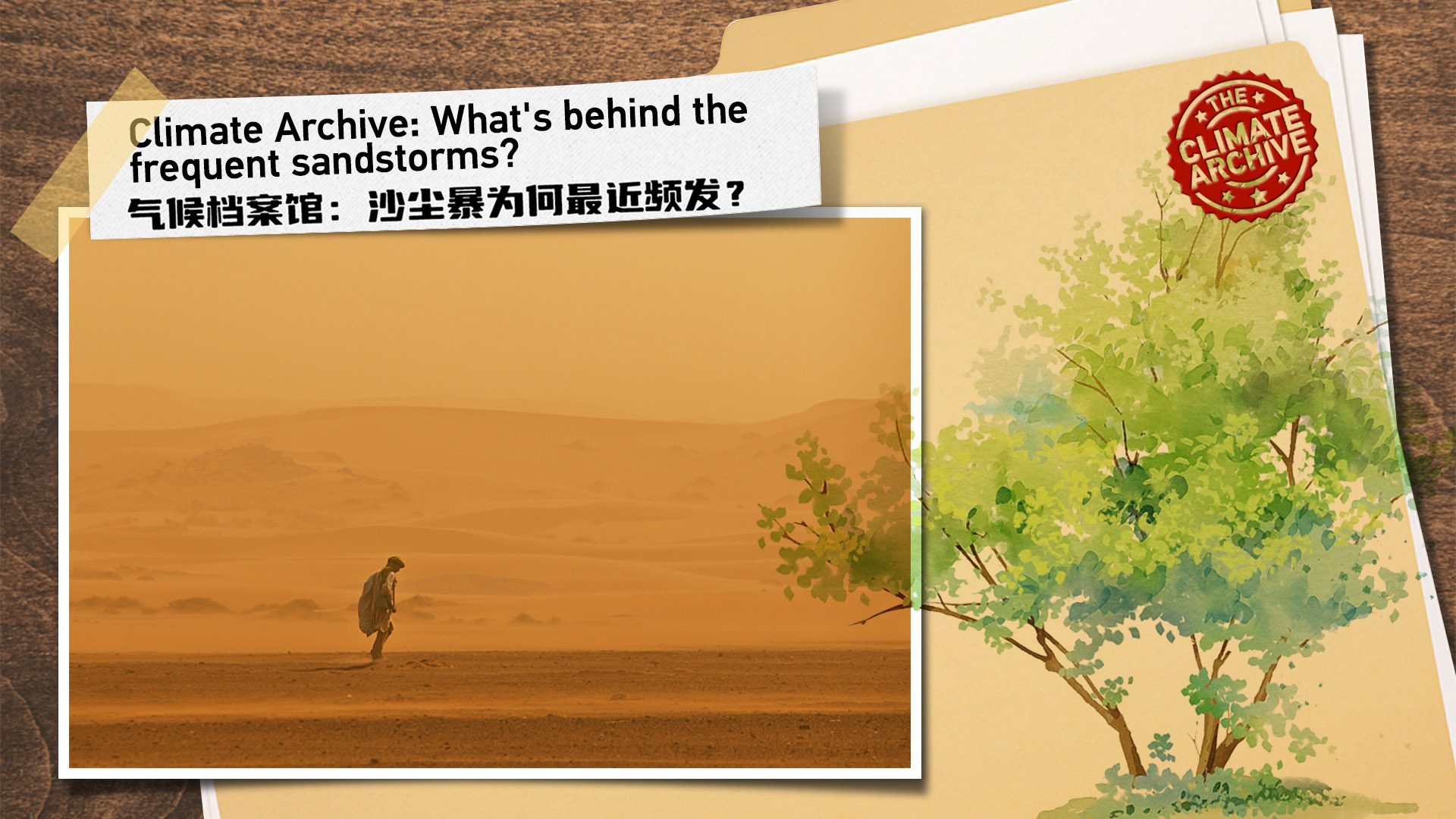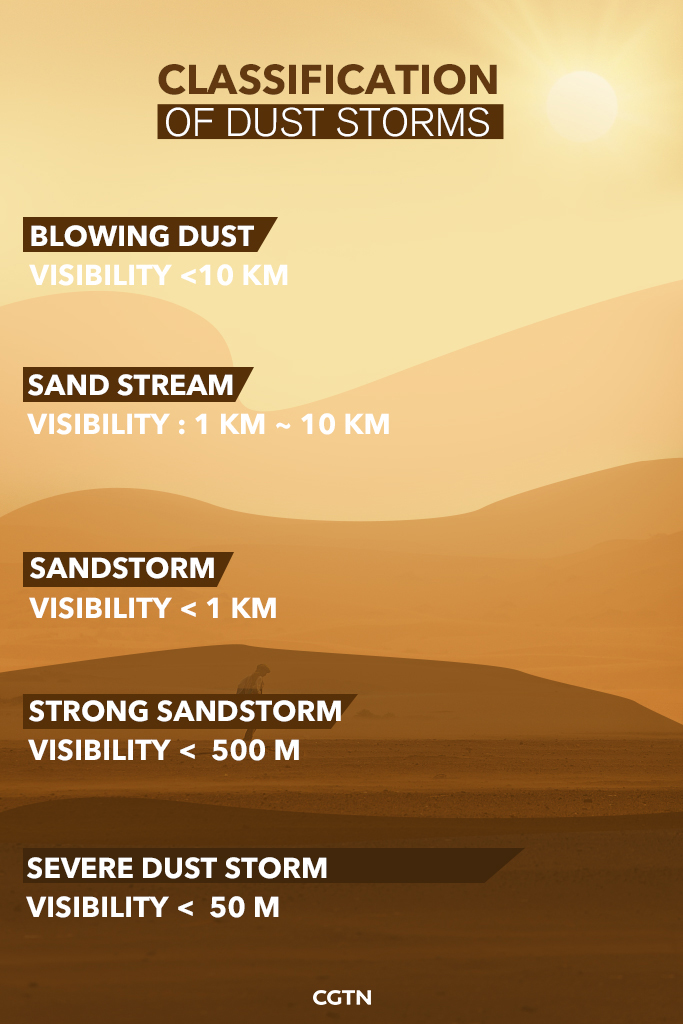
A huge sandstorm originating from Mongolia has swept across many parts of northern China since April 10, shrouding cities in clouds of dust and causing traffic disruption as mounds of sand formed on some highway sections.
On April 11, the National Meteorological Center renewed its blue alert for sandstorms in most northern areas of China, the lowest in the country's four-tier weather warning system, alerting residents that more dust storms could be expected over the next week.
The sandstorm first arrived in cities of north China's Inner Mongolia Autonomous Region on April 10, with the region's Ulanqab City even issuing a red alert – the highest level warning – for the disruptive weather, with visibility in the city down to less than 50 meters as the sky turned orange amid the intense dust.
In addition, the Air Quality Index (AQI) of north China's Tianjin Municipality hit 500 on April 11, which is considered "hazardous" on the AQI scale, while the city's PM10 level reached a concentration of more than 1,200 micrograms per cubic meter.

"Since March this year, China has seen four dusty weather processes," said the chief forecaster of the Central Weather Station. There are three elements of sandstorm formation – sand source, unstable atmospheric circulation and strong winds. Strong winds can pick up large amounts of sand and dust, resulting in lower visibility and the unstable atmospheric circulation allows the dust to be carried further away.
Warming temperatures and scarce precipitation were the main reasons for dust storms in China. From March 4 to 13, temperatures were significantly warmer than normal by 4-6°C in most parts of the country, including 8°C more than normal in parts of southern areas of north China. Still, most areas in the north had little to no precipitation. High temperatures and little rainfall led to no snow cover on the ground in the sand source areas of Northwest China, and together with frequent cold air and windy weather as power sources, they facilitated the occurrence of dusty weather.
Chinese authorities issue health warning amid sandstorms
Sandstorm in Beijing expected to weaken and dissipate by Tuesday evening
The main sources of sand that affect China are not only the arid and semi-arid areas in the north but also the Gobi Desert in Mongolia.

At 1.3 million square kilometers, the Gobi Desert is the northernmost desert in the world. A vast desert and semidesert region of Central Asia, it means "waterless place" in Mongolian and stretches across huge portions of both Mongolia and China.
The formation mechanism of dust storms is very complex, and long-term climate change exacerbates the instability of weather systems and ecological deterioration in sand source areas.
Under the influence of climate change, irrational use of pastures and uncontrolled mineral exploitation, Mongolia is experiencing serious desertification problems, according to a study by Meng Xiaoyu, a researcher at the Desert and Oasis Ecology Laboratory. Studies show that about 76.8 percent of the country's land area is threatened by desertification.
According to a document titled "Climate Change in Mongolia," published by Ministry of the Environment, Japan, during the 1996-2015, Mongolia's grassland ecosystems experienced rapid warming and reduced precipitation. Degraded vegetation and a warm, dry climate have created a potential source of sand in the soil. In 1960, the country had only 18 days of desertification, while this number tripled to 57 days in 2007. Moreover, overgrazing has become increasingly serious in Mongolia since the 1990s. Compared to 1961, livestock density increased to three times in 2017, and the brutal development of animal husbandry has caused widespread ecological degradation of pastures across the country, according to the research by Oyunbileg Munkhzul, a researcher at the Botanical Garden and Research Institute, Mongolian Academy of Science.

In the 1970s, China launched the Three-North Shelter Forestation Project to reduce sandstorms. Sandstorms used to be more severe in China in the past. However, the number of dust storm days per year in Beijing has gradually decreased over the past 50 years as the dust has been substantially attenuated and filtered through the protective forests.
Mongolia's desertification problem requires a more systematic, cooperative and win-win solution. The Gobi Desert has been a harsh environment since ancient times, and with the environmental and climate crisis permeating many aspects of human life, countries need to work together to combat sand and dust.
About Climate Archive
Welcome to CGTN Nature's Climate Archive series, the ultimate source for climate science, expert forums, and the latest climate-related info. Together we delve into this handy climate encyclopedia!
For more:
Climate Archive: Does climate change affect cherry blossoms?
(If you want to contribute and have specific expertise, please contact us at nature@cgtn.com.)